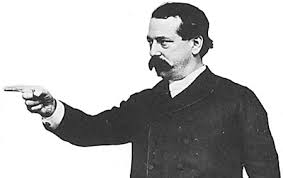This Day in Labor History: December 17, 1894

On December 17, 1894, the American Federation of Labor annual convention begins in Denver. During the convention, AFL founding leader Samuel Gompers lost his reelection bid to John McBride due to the rise of Populism in the labor movement. While this interregnum in Gompers’ domination of the AFL for its four decades would not last long, it is a symbol of the potential for unity between Populists and organized labor in the 1890s.
The Populist movement had risen significantly through the 1880s and into the 1890s. Greater organization had allowed for success in several states and a respectable third party campaign in 1892 gave it hope for further success. But there had long been distrust between urban and rural America. Urban workers often had little interest or even knowledge of the problems of farmers, while farmers often saw the cities with great suspicion and even would sometimes side with owners in strikes because it seemed to them that labor was another conspiracy seeking to impoverish them when they shut down transportation networks.
So when the Populists rose, the core of the movement remained in the farming sectors of the South and the Great Plains, as well as the silver mining camps of the Rocky Mountains. But the latter was mostly a marriage of convenience based around the idea of silver coinage, which was not a big priority among most of the founding Populists. However, it they were to ever succeed on a national political level, that urban-rural divide would have to be overcome. And if that was to happen, it would require some unity between farmers and organized labor.
In 1892, AFL head Samuel Gompers had expressed his suspicions about the Populists. Gompers simply believed that farmers and laborers had entirely different interests. Farmers ultimately were owners and workers were not. He wasn’t the only one who thought that. The socialist Daniel De Leon, who would eventually dream of himself as America’s Lenin, believed that farmers were fundamentally part of the bourgeoisie and workers were the proletariat. Moreover, the working class was heavily Catholic and farmers were not. That fall, the Populists did not do well among the urban working class.
But just because Gompers did not like the Populists didn’t mean that the working class itself was opposed. There began to be growing centers of Populist support among workers. That was especially true among miners and railroad workers, who had more interactions with farmers than most workers. Denver, Butte, Dallas, Cleveland, Topeka, and San Francisco all became centers of labor Populism by 1894. In the midterm elections that year, with the Panic of 1893 and the disastrous response to it by Grover Cleveland reason for workers to think more about electoral alternatives, Populists made significant gains among Catholic workers in the Midwest, though not in the Northeast.
So by the December convention, the labor Populists were ready to challenge Gompers. The AFL was heavily divided. Remember that the federation was and is just that–a federation of different unions with lots of different interests. The idea that the labor movement is a unified force in America is something that has never been borne out by truth. So it was in 1894. Gompers headed the “pure and simple unionists,” who wanted to stay out of politics entirely. Thomas Morgan of Chicago was the leader of the socialist unions. John McBride, head of the United Mine Workers of America, led labor Populists. McBride had worked in the coal mines since he was 9 years old. He joined the Ohio Miners Union in 1870 and became its president in 1883. He helped found the People’s Party in Ohio in 1891 and was elected president of the UMWA in 1892.
None of these three factions really had the majority of American unions. Morgan proposed that the AFL take on a similar role in politics as British unions, becoming the equivalent of the Labour Party that challenged the two-party system. Gompers completely rejected this. So Morgan got his revenge. He threw his support behind McBride to head the AFL. This worked. Gompers was tossed out of office.
The labor Populism that McBride represented came out of the Knights of Labor, with its vague but powerful calls for unity among the working classes. Moreover, they saw the growth of capitalism and, like the Populists themselves, wanted to use their vision of trusts to build interstate organizations that would regulate markets for the benefit of the everyday American instead of the wealthy shareholders. Miners had experimented with the same type of cooperative enterprises that so interested Populist farmers. The mines were as disorganized and overrun by competition as farms.
However, McBride’s Populism was still unpopular with many workers. He also wasn’t a particularly unifying leader, getting into arguments with many other union leaders. The next year, Gompers retook his office. There were still sectors of the labor movement that were interested in Populism, but when that movement declined after the 1896 elections, organized labor’s interest in these solutions largely disappeared along with it. McBride left the presidency of the UMWA when he took over the AFL and after he left the AFL presidency was only a minor player in the labor movement.
McBride died in 1917 in a pretty rough way–a runaway horse knocked him through a plate glass window, which severed key arteries. He bled to death.
I borrowed from Charles Postel’s excellent The Populist Vision for the writing of this post.
This is the 377th post in this series. Previous posts in this series are archived here.
